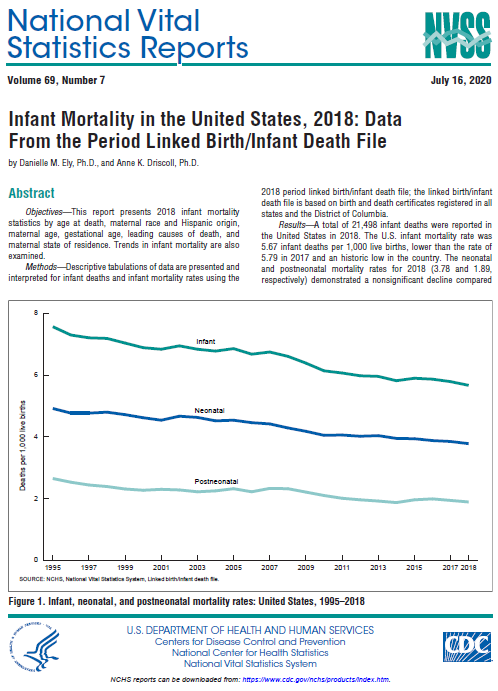Infant Mortality in the United States, 2018: Data From the Period Linked Birth/Infant Death File
Posted on byQuestions for Danielle Ely, Health Statistician and Lead Author of “Infant Mortality in the United States, 2018: Data From the Period Linked Birth/Infant Death File.”
Q: Why does NCHS conduct studies on infant mortality?
DE: NCHS collects data from U.S. jurisdictions on infant deaths to provide national statistics on infant mortality. Infant mortality is considered a key public health indicator for a country.
Q: Can you explain what the Linked Birth/Infant Death File is?
DE: The linked file consists of infant death information linked with the birth certificate information for infants under 1 year of age. Individual birth and death records are selected from their respective files and linked into a single statistical record, thereby establishing a national linked record file. The linked birth/infant death data set is the preferred source for examining infant mortality by race and Hispanic origin. Infant mortality rates by race and Hispanic origin are more accurately measured from the birth certificate compared with the death certificate.
Q: Can you summarize how the infant mortality data varied?
DE: The U.S. infant mortality rate was 5.67 infant deaths per 1,000 live births, lower than the rate of 5.79 in 2017 and an historic low. The mortality rate declined in 2018 for infants of Hispanic women compared with the 2017 rate; changes in rates for other race and Hispanic-origin groups were not statistically significant. The 2018 infant mortality rate for infants of non-Hispanic black women (10.75) was more than twice as high as that for infants of non-Hispanic white (4.63), non-Hispanic Asian (3.63), and Hispanic women (4.86). Infants born very preterm (less than 28 weeks of gestation) had the highest mortality rate (382.20), 186 times as high as that for infants born at term (37–41 weeks of gestation) (2.05). Infant mortality rates by state for 2018 ranged from a low of 3.50 in New Hampshire to a high of 8.41 in Mississippi.
Q: What is the take home message for this report?
DE: Although the infant mortality rate continues to slowly decline, some groups have consistently higher rates than others (for example, by maternal race and Hispanic origin, infants of non-Hispanic black, American Indian or Alaska Native, and Native Hawaiian and Other Pacific Islander women have higher rates than infants of non-Hispanic white, non-Hispanic Asian, and Hispanic women). This information can further our understanding of current infant mortality trends and provide information on where improvements can be made.
Q: Any predictions for 2019 infant mortality data?
DE: We do not predict what will happen for the infant mortality rate in future years. Provisional estimates for each quarter can be found in the Vital Statistics Rapid Release Quarterly Provisional Estimates at https://www.cdc.gov/nchs/nvss/vsrr/infant-mortality-dashboard.htm. These data show a slight increase in the 2019 quarter 2 estimates to 5.69 infant deaths per 1,000 live births. Note that this estimate may be revised when the 2018 quarter 3 estimate becomes available.
Posted on by

